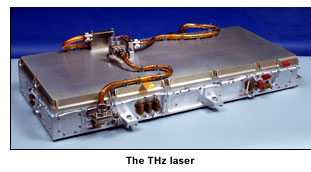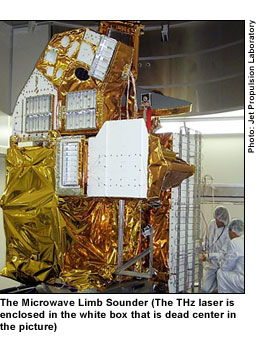SANTA CLARA, Calif., Oct. 4 -- A novel terahertz (THz) laser developed by Coherent and the Jet Propulsion Laboratory (JPL) will enable a NASA environmental research  satellite to provide global mapping of an important ozone-depleting molecule in the earth's atmosphere. The 2.5-THz laser local oscillator (LLO) is the first THz laser to be space-qualified and the first gas laser designed for a long-duration space flight.
satellite to provide global mapping of an important ozone-depleting molecule in the earth's atmosphere. The 2.5-THz laser local oscillator (LLO) is the first THz laser to be space-qualified and the first gas laser designed for a long-duration space flight.
JPL will integrate the LLO into a radiometer that will be mounted on NASA's earth-observing system (EOS) AURA satellite, slated for launch in 2004.
Part of NASA's Earth Science Enterprise, the EOS AURA mission is the third in a series of earth-observing satellites that study the environment and climate change. EOS AURA will be the first satellite to measure the chemistry of the lower atmosphere with multiple instruments, Coherent said. These instruments include an infrared limb-scanning radiometer designed to sound the stratosphere and upper troposphere; an ozone-monitoring instrument that observes solar backscatter radiation; a Fourier-transform spectrometer that provides line-width discrimination of radiative molecular species in the lower atmosphere; and a passive microwave limb-sounding radiometer that will measure a variety of atmospheric species.

The LLO consists of a CO2 laser pumping a methanol laser. DC power generated from the satellite's solar panel is converted to RF energy at about 75 MHz. The RF energy excites the CO2 laser, which then pumps the methanol laser. The CO2 laser emits at 9.69 µm, with the final output from the methanol laser at 118.8 µm, or 2.5 THz.
The laser measures 75 cm x 30 cm x 10 cm and has a mass of 21 Kg. It produces 31 mW of power at 2.5 THz and has a power consumption of just 120W, including all the electronics and the RF power supply for the CO2 laser. Coherent delivered the LLO to JPL in December 2001. It has been tested in operation from -35? C to +60? C, and has passed vibration testing for launch on a Delta II rocket.
For more information, visit: www.coherentinc.com